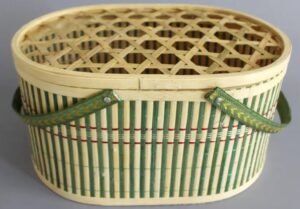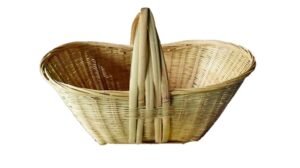Bamboo handicrafts have been captivating the hearts and minds of people around the world for centuries. These beautiful and functional creations not only showcase the natural beauty of bamboo but also reflect the skill and creativity of artisans. In this article, we will explore the world of bamboo handicrafts, from their history and types to their production processes and benefits.

1. The History of Bamboo Handicrafts
Bamboo has been used for handicrafts since ancient times. In many cultures, bamboo was considered a sacred material and was used to make a variety of items, including baskets, furniture, and musical instruments. Over time, the art of bamboo handicrafts has evolved and spread to different parts of the world.
2. Types of Bamboo Handicrafts
There are many different types of bamboo handicrafts, including:
2.1 Bamboo Baskets
Used for storage, shopping, or as decorative items.
2.2 Bamboo Furniture
Chairs, tables, beds, and other pieces that are both stylish and sustainable.
2.3 Bamboo Decorative Items
Such as wall hangings, sculptures, and vases.
2.4 Bamboo Kitchenware
Cutting boards, spoons, and bowls that are eco-friendly and safe for food use.
2.5 Bamboo Jewelry
Unique pieces that add a touch of natural beauty to any outfit.
2.1 Bamboo Baskets
Used for storage, shopping, or as decorative items.
2.2 Bamboo Furniture
Chairs, tables, beds, and other pieces that are both stylish and sustainable.
2.3 Bamboo Decorative Items
Such as wall hangings, sculptures, and vases.
2.4 Bamboo Kitchenware
Cutting boards, spoons, and bowls that are eco-friendly and safe for food use.
2.5 Bamboo Jewelry
Unique pieces that add a touch of natural beauty to any outfit.
3. The Benefits of Bamboo Handicrafts
3.1 Eco-Friendly
Bamboo is a highly sustainable material that grows quickly and requires little water or pesticides.
3.2 Durable
When properly cared for, bamboo handicrafts can last for many years.
3.3 Aesthetically Pleasing
The natural texture and color of bamboo give handicrafts a unique and beautiful look.
3.4 Versatile
Bamboo can be used to make a wide variety of items, from practical to decorative.
Bamboo is a highly sustainable material that grows quickly and requires little water or pesticides.
3.2 Durable
When properly cared for, bamboo handicrafts can last for many years.
3.3 Aesthetically Pleasing
The natural texture and color of bamboo give handicrafts a unique and beautiful look.
3.4 Versatile
Bamboo can be used to make a wide variety of items, from practical to decorative.
4. The Production Process of Bamboo Handicrafts
The production of bamboo handicrafts typically involves several steps:
4.1 Harvesting
Bamboo is harvested at the right time to ensure its quality and strength.
4.2 Preparation
The harvested bamboo is then cleaned, cut, and treated to prevent decay and insect infestation.
4.3 Design and Crafting
Skilled artisans use traditional techniques and modern tools to shape and decorate the bamboo according to their designs.
4.4 Finishing
The final step involves adding finishing touches such as polishing, painting, or varnishing to enhance the appearance and durability of the handicraft.
4.1 Harvesting
Bamboo is harvested at the right time to ensure its quality and strength.
4.2 Preparation
The harvested bamboo is then cleaned, cut, and treated to prevent decay and insect infestation.
4.3 Design and Crafting
Skilled artisans use traditional techniques and modern tools to shape and decorate the bamboo according to their designs.
4.4 Finishing
The final step involves adding finishing touches such as polishing, painting, or varnishing to enhance the appearance and durability of the handicraft.
5. Bamboo Handicrafts Around the World
Bamboo handicrafts are produced in many countries, each with its own unique styles and techniques. Some of the most famous regions for bamboo handicrafts include:
5.1 Asia
Countries like China, Japan, and Thailand are known for their exquisite bamboo handicrafts.
5.2 Africa
In some African countries, bamboo is used to make colorful baskets and other decorative items.
5.3 South America
Bamboo handicrafts from South America often feature bold designs and vibrant colors.
5.1 Asia
Countries like China, Japan, and Thailand are known for their exquisite bamboo handicrafts.
5.2 Africa
In some African countries, bamboo is used to make colorful baskets and other decorative items.
5.3 South America
Bamboo handicrafts from South America often feature bold designs and vibrant colors.
6. Cultural Significance of Bamboo Handicrafts

In many cultures, bamboo handicrafts hold deep cultural and symbolic meanings. They may be associated with festivals, religious ceremonies, or traditional occupations. For example, in some Asian cultures, bamboo baskets are used in wedding ceremonies to symbolize fertility and prosperity.
7. Famous Bamboo Handicraft Artists
There are many talented bamboo handicraft artists around the world who have made significant contributions to the field. Some of these renowned artists include [mention specific names and their notable works].
8. Where to Buy Bamboo Handicrafts
If you’re interested in purchasing bamboo handicrafts, there are several options available:
8.1 Local Craft Fairs and Markets
These are great places to find unique and handmade bamboo handicrafts directly from the artisans.
8.2 Online Marketplaces
Websites like Etsy and Amazon offer a wide range of bamboo handicrafts from different sellers.
8.3 Specialty Stores
Some stores specialize in eco-friendly and sustainable products, including bamboo handicrafts.
8.1 Local Craft Fairs and Markets
These are great places to find unique and handmade bamboo handicrafts directly from the artisans.
8.2 Online Marketplaces
Websites like Etsy and Amazon offer a wide range of bamboo handicrafts from different sellers.
8.3 Specialty Stores
Some stores specialize in eco-friendly and sustainable products, including bamboo handicrafts.
9. How to Care for Bamboo Handicrafts
To ensure the longevity of your bamboo handicrafts, follow these care tips:
9.1 Avoid Exposure to Moisture
Excessive moisture can damage bamboo, so keep your handicrafts away from damp areas.
9.2 Clean Regularly
Use a soft cloth to wipe off dust and dirt. Avoid using harsh chemicals or abrasives.
9.3 Store Properly
When not in use, store your bamboo handicrafts in a cool, dry place.
9.1 Avoid Exposure to Moisture
Excessive moisture can damage bamboo, so keep your handicrafts away from damp areas.
9.2 Clean Regularly
Use a soft cloth to wipe off dust and dirt. Avoid using harsh chemicals or abrasives.
9.3 Store Properly
When not in use, store your bamboo handicrafts in a cool, dry place.
10. DIY Bamboo Handicrafts
For those who enjoy a creative challenge, making your own bamboo handicrafts can be a rewarding experience. There are many DIY projects available, ranging from simple bamboo planters to more complex bamboo lamps. You can find tutorials and inspiration online or in craft books.
11. Bamboo Handicrafts in Interior Design
Bamboo handicrafts can add a touch of natural elegance to your interior design. Consider using bamboo furniture, wall hangings, or decorative items to create a warm and inviting atmosphere. You can also mix and match bamboo with other materials like wood, metal, and fabric for a unique look.
12. The Future of Bamboo Handicrafts
As the demand for sustainable products continues to grow, the future of bamboo handicrafts looks bright. With advancements in technology and design, we can expect to see even more innovative and beautiful bamboo creations in the years to come.
13. Bamboo Handicrafts and Sustainable Living
Choosing bamboo handicrafts is not only a way to beautify your home or office but also a step towards sustainable living. By supporting artisans who use sustainable materials and techniques, you are contributing to a more environmentally friendly future.
14. Bamboo Handicrafts as Gifts
Bamboo handicrafts make excellent gifts for various occasions. Whether it’s a birthday, wedding, or housewarming, a unique bamboo item can be a thoughtful and meaningful present. Consider giving a bamboo basket filled with goodies or a bamboo sculpture as a special gift.
15. Bamboo Handicrafts and Tourism
In some areas, bamboo handicrafts are an important part of the local tourism industry. Visitors can watch artisans at work, learn about the history and culture of bamboo handicrafts, and purchase unique souvenirs. This not only supports the local economy but also promotes cultural exchange.
16. The Versatility of Bamboo Handicrafts
Bamboo handicrafts can be used in a variety of settings, from homes and offices to gardens and outdoor spaces. They can be both practical and decorative, adding a touch of natural beauty to any environment.
17. Bamboo Handicrafts and Fashion
Bamboo is also being used in the fashion industry to create unique accessories and clothing items. From bamboo jewelry to bamboo fabric clothing, these sustainable fashion choices are gaining popularity.
18. Bamboo Handicrafts and Children
Bamboo handicrafts can be a great way to introduce children to the beauty of nature and the art of craftsmanship. There are many kid-friendly bamboo crafts projects available, such as making bamboo wind chimes or painting bamboo baskets.
19. Bamboo Handicrafts and Wellness
Some people believe that bamboo has healing properties and can promote relaxation and well-being. Bamboo handicrafts such as bamboo mats and pillows can be used in yoga and meditation practices.
20. Bamboo Handicrafts and Home Decor Themes
Bamboo handicrafts can be incorporated into different home decor themes, such as bohemian, rustic, or modern. They can add a touch of warmth and texture to any space.
21. Bamboo Handicrafts and Events
Bamboo handicrafts can be used to decorate events such as weddings, parties, and corporate functions. They can create a unique and memorable atmosphere.
22. Bamboo Handicrafts and Art Exhibitions
Bamboo handicrafts are often featured in art exhibitions and galleries, showcasing the creativity and skill of artisans. These exhibitions can be a great source of inspiration for those interested in bamboo handicrafts.
23. Bamboo Handicrafts and Community Projects
In some communities, bamboo handicrafts are used as a way to promote economic development and social change. Artisans work together to create beautiful and functional bamboo products that can be sold locally or internationally.
24. Bamboo Handicrafts and Conservation
By choosing bamboo handicrafts, you are supporting the conservation of bamboo forests. Bamboo is a renewable resource that can help reduce deforestation and protect the environment.
25. Conclusion
Bamboo handicrafts are a unique and beautiful art form that offer many benefits. From their eco-friendliness and durability to their cultural significance and aesthetic appeal, these creations are truly something special. Whether you’re a collector, a DIY enthusiast, or simply someone who appreciates beautiful things, bamboo handicrafts are definitely worth exploring.

Leave a Reply